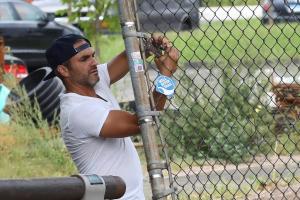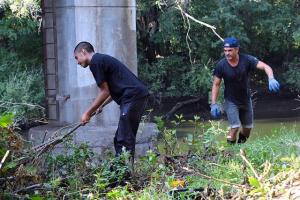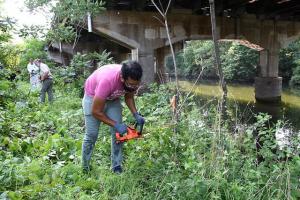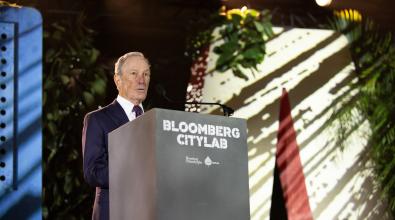Lessons from CityLab: How cutting a hole in a L.A. fence opened the door to innovation in New Haven

Just to be clear: Ben Berkowitz doesn’t want you break any laws. But he does think urbanists can do a lot of good in their communities by pushing the limits.
That’s a lesson Berkowitz, CEO and co-founder of the civic technology company SeeClickFix, picked up in Los Angeles in 2014 when attending CityLab, an annual conference sponsored by Bloomberg Philanthropies, the Aspen Institute, and The Atlantic. And it’s one he’s put to great use in the city where he lives and works, New Haven, Conn.
As part of the conference that year, Berkowitz and other attendees took a guided tour of the long-neglected Los Angeles Riverfront, which the city and community groups were revitalizing with parks and trails. One thing they learned along the way: A turning point in the L.A. project came when an activist took public access to the concrete waterway into his own hands and used wirecutters to cut a hole in the fence.
“He didn’t ask permission — he just created a trail where there wasn’t one,” Berkowitz recalled, noting the many layers of planning and approval that might typically be involved with such an act. “By cutting a hole in the fence, he effectively created the public access. It allowed people to flow through and start thinking about what the river could be.”
The story immediately reminded Berkowitz, whose company works with hundreds of cities on their 311 systems, of a stalled side project he had been working on in New Haven — to help build a trail along a neglected stretch of the Mill River. The biggest obstacle to public access was a thicket of Japanese knotweed that made it difficult to see the river, let alone get close to it. “When I got home, I called [a friend] and said, ‘Let’s grab some machetes,’” Berkowitz said. “And we got out there and started cutting a trail along the river.”
They couldn’t have predicted what happened next. Prompted by pictures of Berkowitz’s trailblazing, another friend went to the riverfront and saw an abandoned bus terminal that he thought might be a perfect home for his digital marketing company. That friend then partnered with a developer to buy the property and turn it into a co-working space, called “The District,” and build a stretch of waterfront trail along with a public amphitheater and, soon, boat launches.
As that development brought more people to the riverfront — a restaurant recently opened there, and a school for software engineers is coming — it built momentum to open up the waterfront further. The state came through with a quarter-million dollar grant to develop another section of trail, and other sections are in the planning stages.
“It’s insane how quickly it went from pulling out machetes to having a fully developed 60,000 square-foot property, plus multiple sections of trail developed,” Berkowitz said, noting that many others, from volunteers to leaders from the city, state, business, and nonprofit communities, have made the progress possible. “Sometimes, you just have to ask for forgiveness instead of permission, and lean in and cut that first hole.”
As it happened, Berkowitz actually did cut a hole in a fence, too. By last summer, the private company that developed The District had finished most of the trail work but had not yet removed a chain-link fence blocking public access. Berkowitz asked the owners if they’d mind if he cut it down. They gave him a bolt cutter to do it.
Berkowitz said the initial trailblazing he and his friend did would not have infringed on any laws. “We were definitely on public property, and removing invasive plants that weren’t supposed to be there,” he said. “I would not encourage people to break laws, but I would encourage people to push boundaries while respecting the laws. We were not trespassing or harming the environment or anyone’s wellbeing. All we were doing was pushing an agenda through volunteerism, within our legal grounds.”
“And it felt really good,” he added. “This was totally different than writing a report, or applying for a grant, or going through the hurdles of bureaucracy. It felt like we were accomplishing something — opening a trail and the imaginations of a lot of people.”





